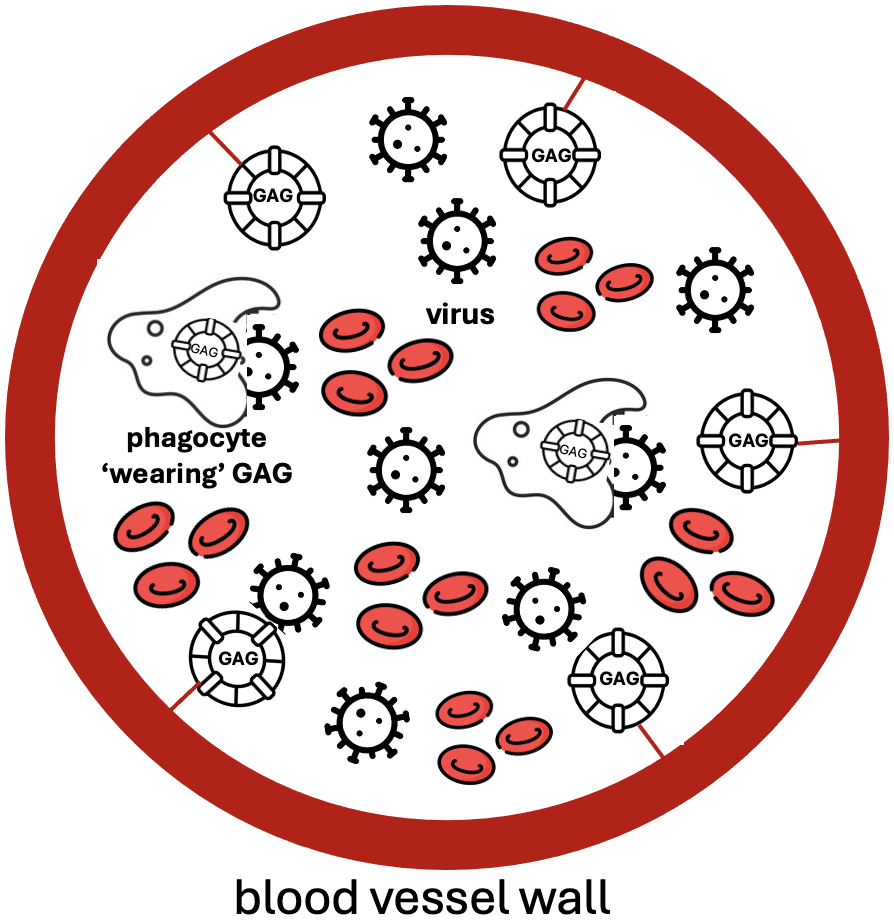Meet the Scientist
Dr. Tem Morrison
Professor
Department of Immunology & Microbiology

How do we capture and remove virus from the bloodstream?
The blood that flows throughout your body plays many important roles in keeping you healthy. It can deliver oxygen to muscles, send chemical messages from one organ to another, and monitor for any foreign invaders like bacteria or viruses. Dr. Thomas ‘Tem’ Morrison leads a research team at the University of Colorado Anschutz Medical Campus in the Department of Immunology and Microbiology that studies how our blood can detect and deal with viral infections.
The Morrison lab is specifically interested in how your body can immediately detect and remove virus particles from your bloodstream. You can think of your blood like traveling a long lazy river at a water park. There are lots of different twists and turns that the blood takes as it flows out of your heart, circulates around the entire body, and returns back to the heart. Like at a water park, there are lifeguards surrounding the edge of the bloodstream watching for any disruptions or trouble in the bloodstream and serve as first responders to an issue. A virus might look like a kid causing trouble in the lazy river (bloodstream) who tries to invite more of their wild friends to cause a ruckus. If that troublesome kid is left unattended and not called out, it’s likely they will recruit more kids to their wild games and cause more disruption and damage (like when a virus replicates and spreads).
The Morrison lab is specifically interested in how your body can immediately detect and remove virus particles from your bloodstream. You can think of your blood like traveling a long lazy river at a water park. There are lots of different twists and turns that the blood takes as it flows out of your heart, circulates around the entire body, and returns back to the heart. Like at a water park, there are lifeguards surrounding the edge of the bloodstream watching for any disruptions or trouble in the bloodstream and serve as first responders to an issue. A virus might look like a kid causing trouble in the lazy river (bloodstream) who tries to invite more of their wild friends to cause a ruckus. If that troublesome kid is left unattended and not called out, it’s likely they will recruit more kids to their wild games and cause more disruption and damage (like when a virus replicates and spreads).
How does Tem and his research team answer their questions in the lab?
Tem’s research team studies different sentinels – or lifeguards in our water park analogy - that monitor the bloodstream. These sentinels are the very first line of defense for the body in response to detecting a virus in the blood. The systems that respond immediately to danger, like a viral infection in the body, are called the innate response. What a particular virus looks like on its surface or viral coat (size, shape, spike proteins) helps the innate system identify and isolate those particles away from everything else in the blood. If we can better understand what the viruses look like and the tools that our bodies use to find them, we can develop better treatments to prevent and decrease the impact of infection.
The first type of sentinel (lifeguard) that Tem’s team studies are cells that line the blood vessels and have specific molecules dangling into the bloodstream, like a life preserver ring. These molecules are called glycosaminoglycans, or GAGs. GAGs are built with different combinations of chemical building blocks so that they can recognize different coats of viruses as they might float past. Once a virus is recognized, these GAGs (life preserver rings) latch onto and cover the virus’s surface, which signals the body to pull it in and clear it from the bloodstream.
The second part of the system that the Morrison lab studies are mobile cells that patrol within the bloodstream to recognize viruses – these specialized lifeguards have their own GAGs and many other highly specific surveillance tools. Once these mobile cells recognize an invading virus, they grab onto it and engulf it within themselves to break it apart using internal chemical weapons. These cells are appropriately called phagocytes, which means “cells that eat”.The Morrison research team designs experiments in mice to study what happens when virus is injected into the blood. They look at how cells that express GAGs can flag down viruses to call for their removal and see how phagocytes respond to clear the virus out of circulation. There are different entrance and exit points to the bloodstream, with the liver and spleen serving as two of the main areas where contaminating invaders like viruses are filtered out or removed from the bloodstream.

When a virus has been flagged and travels to the liver, it is then removed and not allowed to continue circulating.
Why is the research that Tem and his team work on in their lab so important?
Tem and his research team are trying to figure out how to remove viruses from the blood of infected individuals to decrease illness and reduce future infections. The reason that it’s important to remove viruses from the blood is that many of the viruses Dr. Morrison’s lab studies are transmitted (moved) between the blood from a human host by mosquitos taking a drink of the blood to infecting a new person with that same virus upon a second mosquito bite. If there are very few viruses in the blood when a mosquito bites, this limits or prevents the virus from traveling as a passenger through the mosquito to infect a new person upon the next bite and causing illness. Additionally, the higher the levels of virus detected in the blood, the worse the disease often is for the infected person.
The viruses that this research could impact include a variety of viruses that routinely cause massive health issues across the globe and include chikungunya, dengue, Zika, eastern equine encephalitis, and La crosse virus. Tem’s lab is focused on how these viruses infect humans and how our bodies work to clear them. By improving our knowledge of these viral infections we can more strategically design treatments to lessen the severe illnesses they can cause.
The viruses that this research could impact include a variety of viruses that routinely cause massive health issues across the globe and include chikungunya, dengue, Zika, eastern equine encephalitis, and La crosse virus. Tem’s lab is focused on how these viruses infect humans and how our bodies work to clear them. By improving our knowledge of these viral infections we can more strategically design treatments to lessen the severe illnesses they can cause.
If you want to learn more about the scientist, please head to their official CU webpage.